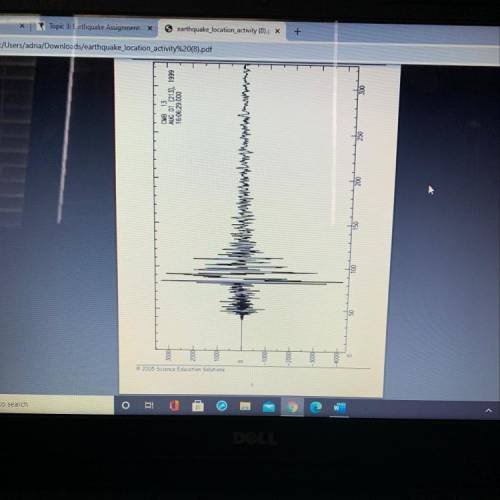Your answers below.
Pasadena, California (PAS)
P Wave Arrival Time (seconds)
S Wave Arr...

Physics, 08.09.2020 01:01 peralesdavid34
Your answers below.
Pasadena, California (PAS)
P Wave Arrival Time (seconds)
S Wave Arrival Time (seconds)
• Calculate - P Time (subtract P time from time)
Dugway, Utah (DUG)
P Wave Arrival Time (seconds)
S Wave Arrival Time (seconds)
• Calculate S-P Time (subtract P time from S time)
Berkley, California (CMB)
P Wave Arrival Time (seconds)
S Wave Arrival Time (seconds)
Calculate S-P Time (subtract P time from S time)
© 2005 Science Education Solutions
For earthquake locati.pdf


Answers: 3


Other questions on the subject: Physics

Physics, 22.06.2019 05:10, adrianaglass12
A- a of 8.00 cm a of 34.0 nc. a , -, a of 25.0 nc is on of a of 15.0 cm .be toto aof ? a) b) c) j d) e)
Answers: 1

Physics, 22.06.2019 17:00, jenn8055
In the future, people will only enjoy one sport: electrodisc. in this sport, you gain points when you cause metallic discs hovering on a field to exchange charge. you are an electrodisc player playing the popular four disc variant. the disks have charges of qa = −8.0 µc, qb = −2.0 µc, qc = +5.0 µc, and qd = +12.0 µc. (1) you bring two disks together and then separate them. you measure the resulting charge of these two disks and find that it is +5.0 µc per disk. which two disks did you bring together? (a) a and b (b) a and c (c)a and d (d)b and c(e) b and d (f) c and d. (2) you bring three disks together and then separate them. you measure the resulting charge of these three disks and find that it is +3.0 µc per disk. which three disks did you bring together? a, b, and c (a) a, b, and d (c) a, c, and d (d) b, c, and d. (3) given the resulting charge of each disk measured in (b) is +3.0 µc, how many electrons would you need to add to a disk of this charge to electrically neutralize it? electrons
Answers: 3

Physics, 22.06.2019 17:50, arunamvr
Which of the following best describes internal energy? a. the difference between the kinetic and potential energies of the particles in a system b. the sum of the kinetic and potential energies of the particles in a system c. the sum of the kinetic and thermal energies of the particles in a system d. the difference between the kinetic and thermal energies of the particles in a system
Answers: 2

Physics, 22.06.2019 20:20, SoccerHalo
The temperature in gavin's oven is a sinusoidal function of time. gavin sets his oven so that it has a maximum temperature of 280°f and a minimum temperature of 240°. once the temperature hits 280°, it takes 20 minutes before it is 280° again. gavin's cake needs to be in the oven for 30 minutes at temperatures at or above 270°. he puts the cake into the oven when it is at 260° and rising. how long will gavin need to leave the cake in the oven? (round your answer to the nearest minute.)
Answers: 3
You know the right answer?
Questions in other subjects:

History, 21.02.2020 02:27









English, 21.02.2020 02:28



